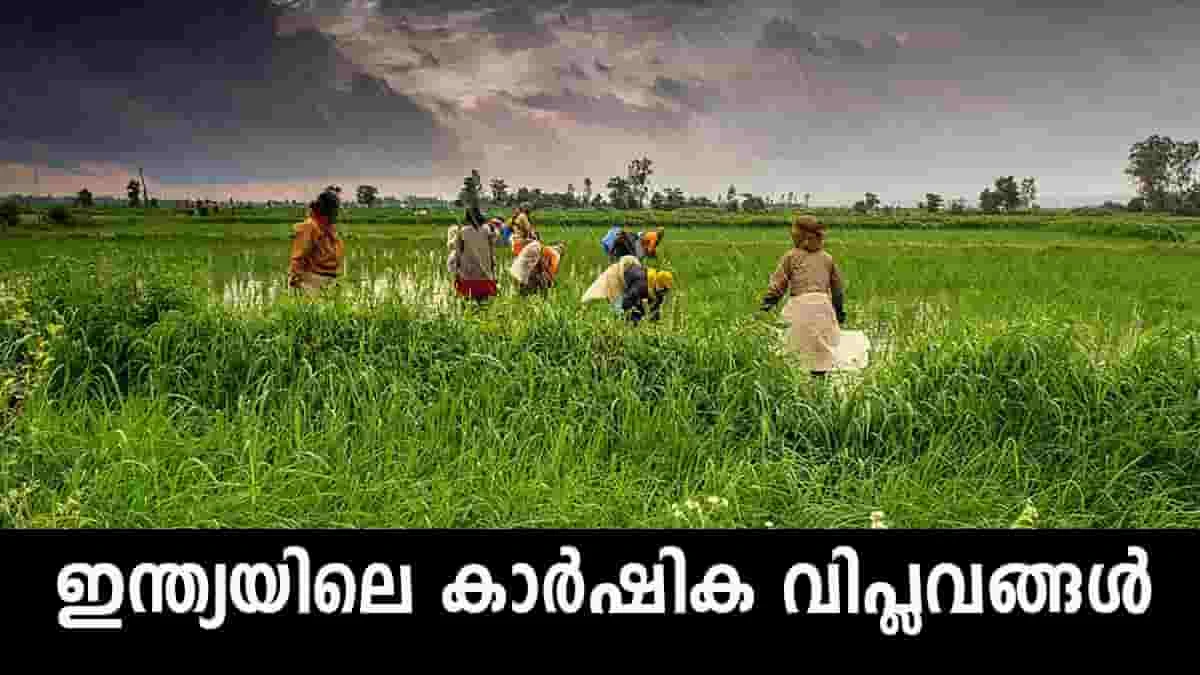India has witnessed three major agricultural revolutions that have had a significant impact on the country's economy and society. These agricultural revolutions have transformed the agricultural practices and productivity of the country. The first agricultural revolution, known as the Green Revolution, began in the 1960s and focused on the use of modern farming techniques to increase crop yields. The second agricultural revolution, known as the White Revolution or Operation Flood, began in the 1980s and aimed to increase milk production through the dairy sector. The third agricultural revolution, known as the Blue Revolution, began in the 2000s and focused on increasing fish production through modern aquaculture techniques. These agricultural revolutions have played a crucial role in improving food security, reducing poverty, and promoting economic growth. In this post, we will discuss the major agricultural revolutions in India and their impact, especially in the context of Kerala for upcoming Kerala PSC exams.
ഹരിത വിപ്ലവം (GREEN REVOLUTION)
- കൃത്രിമ വളങ്ങൾ, കീടനാശിനികൾ, ആധുനിക ജലസേചന മാർഗ്ഗങ്ങൾ, അത്യുൽപ്പാദന ശേഷിയുള്ള വിത്തുകൾ, ആധുനിക യന്ത്ര സംവിധാനങ്ങൾ എന്നിങ്ങനെ നൂതന കൃഷി രീതികൾ സ്വീകരിച്ചു് കാര്ഷികരംഗത്തുണ്ടാക്കിയ അത്ഭുതകരമായ മാറ്റമാണ് ഹരിത വിപ്ലവം.
- അന്താരാഷ്ട്രതലത്തിൽ ഹരിതവിപ്ലവത്തിന് തുടക്കം കുറിച്ചത് നോർമൻ ഇ.ബോർലോഗ് എന്ന മെക്സിക്കൻ ശാസ്ത്രജ്ഞനാണ്.
- ഇന്ത്യയിൽ ഹരിത വിപ്ലവത്തിന്റെ ഉപജ്ഞാതാവ് ഡോ. എം.എസ്.സ്വാമിനാഥൻ ആണ്
- ഇന്ത്യയിൽ ഹരിത വിപ്ലവത്തിന്റെ രണ്ടാം ഘട്ടം അറിയപ്പെടുന്നുത പ്രോട്ടീൻ റവല്യൂഷൻ എന്നാണ്, നരേന്ദ്രമോദിയും അരുൺ ജെയ്റ്റ്ലിയും ചേർന്നാണ് ഹരിത വിപ്ലവത്തിന്റെ രണ്ടാം പതിപ്പ് രൂപപ്പെടുത്തിയത്, ഉയർന്ന കാർഷിക ഉത്പാദനം കൈവരിക്കുക എന്നതാണ് ഈ ഘട്ടത്തിൽ ലക്ഷ്യമിടുന്നത്
ഹരിത വിപ്ലവം പ്രധാന ചോദ്യോത്തരങ്ങൾ
- ഹരിത വിപ്ലവത്തിന്റെ പിതാവ് - നോര്മാന് ബോർലോഗ് (USA)
- നോര്മാന് ബോര് ലോഗിന് സമാധാനത്തിനുള്ള നൊബേല് പുരസ്ക്കാരം ലഭിച്ച വര്ഷം - 1970
- ഹരിത വിപ്ലവത്തിന്റെ ജന്മദേശം - മെക്സിക്കോ
- ഹരിത വിപ്ലവത്തിന്റെ ഏഷ്യയിലെ ഗേഹം എന്നറിയപ്പെടുന്നത് - ഫിലിപ്പൈന്സ്
- ഇന്ത്യയിലെ ഹരിത വിപ്ലവത്തിന്റെ പിതാവ് എന്നറിയപ്പെടുന്നത് - ഡോ. എം.എസ്. സ്വാമിനാഥന്
- കാര്ഷിക രംഗത്തെ വിപ്ലവകരമായ മാറ്റത്തെ വിശേഷിപ്പിക്കുന്നത് - ഹരിത വിപ്ലവം
- ഹരിത വിപ്ലവം കൊണ്ട് നേട്ടമുണ്ടാക്കിയ ഭക്ഷ്യധാന്യങ്ങള് - അരി, ഗോതമ്പ്
- ഹരിത വിപ്ലവത്തിലൂടെ കൂടുതല് ഉത്പാദിപ്പിച്ച ധാന്യം - ഗോതമ്പ്
- ഹരിത വിപ്ലവം കൊണ്ട് ഏറ്റവും കൂടുതല് നേട്ടമുണ്ടാക്കിയ ഇന്ത്യന് സംസ്ഥാനം - പഞ്ചാബ്
- ഹരിത വിപ്ലവം ഇന്ത്യയിൽ ശക്തമായത് ഏത് പദ്ധതി കാലഘട്ടത്തിൽ - 1966 - 69 റോളിംഗ് പദ്ധതി
- ഹരിത വിപ്ലവ കാലഘട്ടത്തിലെ ഇന്ത്യയിലെ കൃഷി മന്ത്രി ആരായിരുന്നു - സി. സുബ്രഹ്മണ്യന്
- ഹരിത വിപ്ലവത്തിലൂടെ ലോകത്തിലെ ഏറ്റവും വലിയ ഭക്ഷ്യോത്പാദകരായി ഇന്ത്യമാറിയ കാലഘട്ടം - 1978-80
ധവള വിപ്ലവം (WHITE REVOLUTION)
- പാലിന്റെയും പാലുല്പന്നങ്ങളുടെയും ഉത്പാദന വർദ്ധനവ് ലക്ഷ്യമാക്കി ആരംഭിച്ച പദ്ധതി.
- വർഗ്ഗസങ്കരണത്തിലൂടെ മികച്ചയിനം കന്നുകാലികളെ വികസിപ്പിച്ചെടുക്കാനും അതുവഴി ലക്ഷ്യം നേടാനും ഈ വിപ്ലവത്തിലൂടെ സാധിച്ചു.
- ഡോ . വർഗീസ് കുര്യനാണ് ധവള വിപ്ലവത്തിന് നേതൃതം നൽകിയത്.
- ധവള വിപ്ലവത്തിന്റെ പിതാവ് ഡോ. വർഗീസ് കുര്യനാണ്
| STUDY MATERIAL FOR KERALA PSC EXAMS | |
|---|---|
|
| |
ധവള വിപ്ലവം പ്രധാന ചോദ്യോത്തരങ്ങൾ
- ഇന്ത്യയിലെ ധവള വിപ്ലവത്തിന്റെ പിതാവ് - ഡോ. വര്ഗ്ഗീസ് കുരൃന്
- ഡോ. വര്ഗീസ് കുര്യന്റെ ജന്മദേശം കോഴിക്കോട്
- ദേശീയ ക്ഷീരവികസന ബോര്ഡ് നിവലില് വന്ന വര്ഷം - 1920
- മാഗ്സസെ പുരസ്കാരം നേടിയ ആദ്യ മലയാളി - ഡോ. വര്ഗീസ് കുര്യന്
- ഇന്ത്യയിലെ ക്ഷീരവികസന ബോര്ഡിന്റെ പ്രധാനക്രേന്ദം സ്ഥിതിചെയ്യുന്ന സംസ്ഥാനം - ഗുജറാത്ത്
- സമീകൃതാഹാരം എന്നറിയപ്പെടുന്നത് - പാല്
- പാലില് ജലത്തിന്റെ അളവ് എത്ര ശതമാനം ആണ് - 88 ശതമാനം
- പാലിനു രുചി നല്കുന്ന ഘടകം ഏതാണ് - ലാക്ടോസ്
- പാലില് അടങ്ങിയിരിക്കുന്ന പ്രധാന പ്രോട്ടീന് - കാസീന്
- പാലിനു വെളുത്തനിറം നല്കുന്നത് - കാസീന്
- പാലിനു നേരിയ മഞ്ഞനിറം നല്കുന്ന ഘടകം - റൈബോ ഫ്ളാവിൻ
- ഏറ്റവും കൂടുതല് പാല് ഉത്പാദിപ്പിക്കുന്ന ജീവി - തിമിംഗലം
- കരയില് ഏറ്റവും കൂടുതല് പാല് ഉല്പ്പാദിപ്പിക്കുന്ന ജീവി - ആന
| വിപ്ലവങ്ങൾ | ഉത്പന്നം / ലക്ഷ്യം | വിപ്ലവത്തിന്റെ പിതാവ്/മാതാവ് |
|---|---|---|
| ഹരിത വിപ്ലവം (Geen Revolution) | ഭക്ഷ്യ ധാന്യ ഉത്പാദനം | എം.എസ്.സ്വാമിനാഥൻ |
| നിത്യഹരിത വിപ്ലവം (Evergreen Revolution) | കാർഷിക മേഖല (ലക്ഷ്യം - സാങ്കേതിക വികസനത്തിൽ പാരിസ്ഥിതിക തത്വങ്ങളുടെ സംയോജനം) | എം.എസ്. സ്വാമിനാഥൻ |
| പ്രോട്ടീൻ വിപ്ലവം (Protein Revolution) | ഹരിത വിപ്ലവത്തിന്റെ രണ്ടാം പതിപ്പ് | നരേന്ദ്രമോദിയും അരുൺ ജെയ്റ്റ്ലിയും ചേർന്ന് രൂപപ്പെടുത്തിയത് |
| ധവള വിപ്ലവം (White Revolution) | പാലും, പാല് ഉത്പന്നങ്ങളും | ഡോ.വർഗ്ഗീസ് കുര്യൻ |
| നീല വിപ്ലവം (Blue Revolution) | മത്സ്യം ഉത്പാദനം | ഡോ. അരുൺ കൃഷ്ണൻ |
| മഞ്ഞ വിപ്ലവം (Yellow Revolution) | എണ്ണ കുരുക്കള് (സൂര്യകാന്തി, കടുക് മുതലായ എണ്ണ കുരുക്കൾ) | സാം പിട്രോഡ |
| ചുവപ്പ് വിപ്ലവം (Red Revolution) | തക്കാളി, മാംസc ഉത്പാദനം | - |
| പിങ്ക് വിപ്ലവം (Pink Revolution) | ഉള്ളി, കൊഞ്ച്, ഫാർമസ്യൂട്ടിക്കൽ | ദുർഗേഷ് പട്ടേൽ |
| സുവര്ണ്ണ വിപ്ലവം (Golden Revolution) | പഴം, പച്ചക്കറി, തേൻ | നിർപഖ് ടുതേജ് |
| രജത വിപ്ലവം (Silver Revolution) | മുട്ട ഉല്പാദനം, കോഴി വളർത്തൽ | ഇന്ദിരാഗാന്ധി (Mother of Revolution) |
| സിൽവർ ഫൈബർ വിപ്ലവം (Silver Fiber Revolution) | കോട്ടൻ വ്യവസായം | - |
| കറുപ്പ് വിപ്ലവം (Black Revolution) | പെട്രോളിയം ഉത്പന്നങ്ങൾ | - |
| ഗ്രേ വിപ്ലവം (Grey Revolution) | രാസവളങ്ങളുടെ ഉത്പാദനം | - |
| ബ്രൗൺ വിപ്ലവം (Brown Revolution) | തുകലിന്റെയും ഉത്പാദനം | - |
| റൌണ്ട് വിപ്ലവം (Round Revolution) | ഉരുളക്കിഴങ്ങിന്റെ ഉത്പാദനം | - |
| മഴവില് വിപ്ലവം (Rainbow Revolution) | കാര്ഷിക മേഖലയിലെമൊത്ത ഉത്പാദന വർധന | - |
Agricultural revolutions refer to a significant change in agricultural practices, techniques, and productivity. India has witnessed three major agricultural revolutions, which have had a significant impact on the country's economy and society. These agricultural revolutions are:
First Agricultural Revolution: The first agricultural revolution in India was marked by the introduction of modern farming techniques and practices. It began in the 1960s and is also known as the Green Revolution. The Green Revolution led to an increase in crop yields due to the use of high-yielding varieties of seeds, fertilizers, and pesticides. The focus was on increasing the production of wheat and rice, which were the staple foods of the country.
Second Agricultural Revolution: The second agricultural revolution in India began in the 1980s and is also known as the White Revolution or Operation Flood. This revolution focused on the dairy sector and aimed to increase milk production by promoting the use of artificial insemination, improving animal nutrition, and increasing the number of milk cooperatives.
Third Agricultural Revolution: The third agricultural revolution in India began in the 2000s and is also known as the Blue Revolution. This revolution focused on increasing fish production through the use of modern aquaculture techniques and promoting the development of fish farms.
In Kerala, the state government has taken several initiatives to promote sustainable agriculture practices, including organic farming, seed banks, and promoting the cultivation of traditional crops. The state has also implemented various schemes to support farmers, including crop insurance, subsidies, and financial assistance. Kerala has also taken significant steps to promote the dairy sector, with the establishment of the Kerala Livestock Development Board (KLDB) and the Milkfed Dairy Project.
In conclusion, the agricultural revolutions in India have had a significant impact on the country's economy and society, and Kerala has made significant strides in promoting sustainable agriculture practices and supporting farmers.
First Agricultural Revolution: The first agricultural revolution in India was marked by the introduction of modern farming techniques and practices. It began in the 1960s and is also known as the Green Revolution. The Green Revolution led to an increase in crop yields due to the use of high-yielding varieties of seeds, fertilizers, and pesticides. The focus was on increasing the production of wheat and rice, which were the staple foods of the country.
Second Agricultural Revolution: The second agricultural revolution in India began in the 1980s and is also known as the White Revolution or Operation Flood. This revolution focused on the dairy sector and aimed to increase milk production by promoting the use of artificial insemination, improving animal nutrition, and increasing the number of milk cooperatives.
Third Agricultural Revolution: The third agricultural revolution in India began in the 2000s and is also known as the Blue Revolution. This revolution focused on increasing fish production through the use of modern aquaculture techniques and promoting the development of fish farms.
In Kerala, the state government has taken several initiatives to promote sustainable agriculture practices, including organic farming, seed banks, and promoting the cultivation of traditional crops. The state has also implemented various schemes to support farmers, including crop insurance, subsidies, and financial assistance. Kerala has also taken significant steps to promote the dairy sector, with the establishment of the Kerala Livestock Development Board (KLDB) and the Milkfed Dairy Project.
In conclusion, the agricultural revolutions in India have had a significant impact on the country's economy and society, and Kerala has made significant strides in promoting sustainable agriculture practices and supporting farmers.




























0 Comments